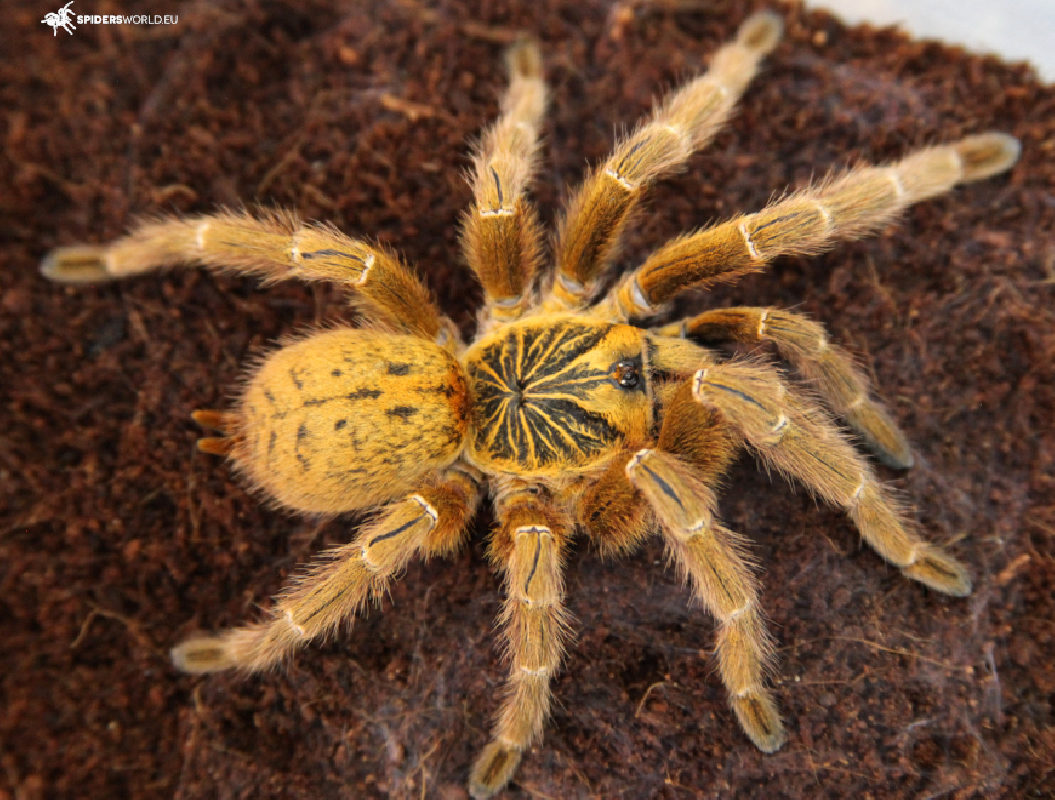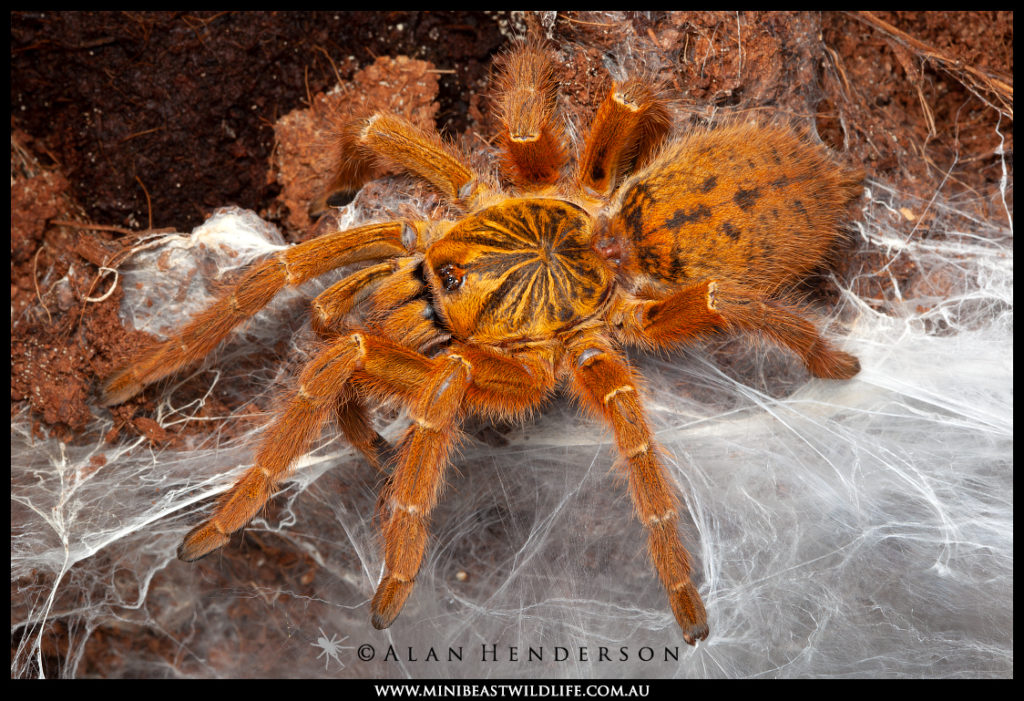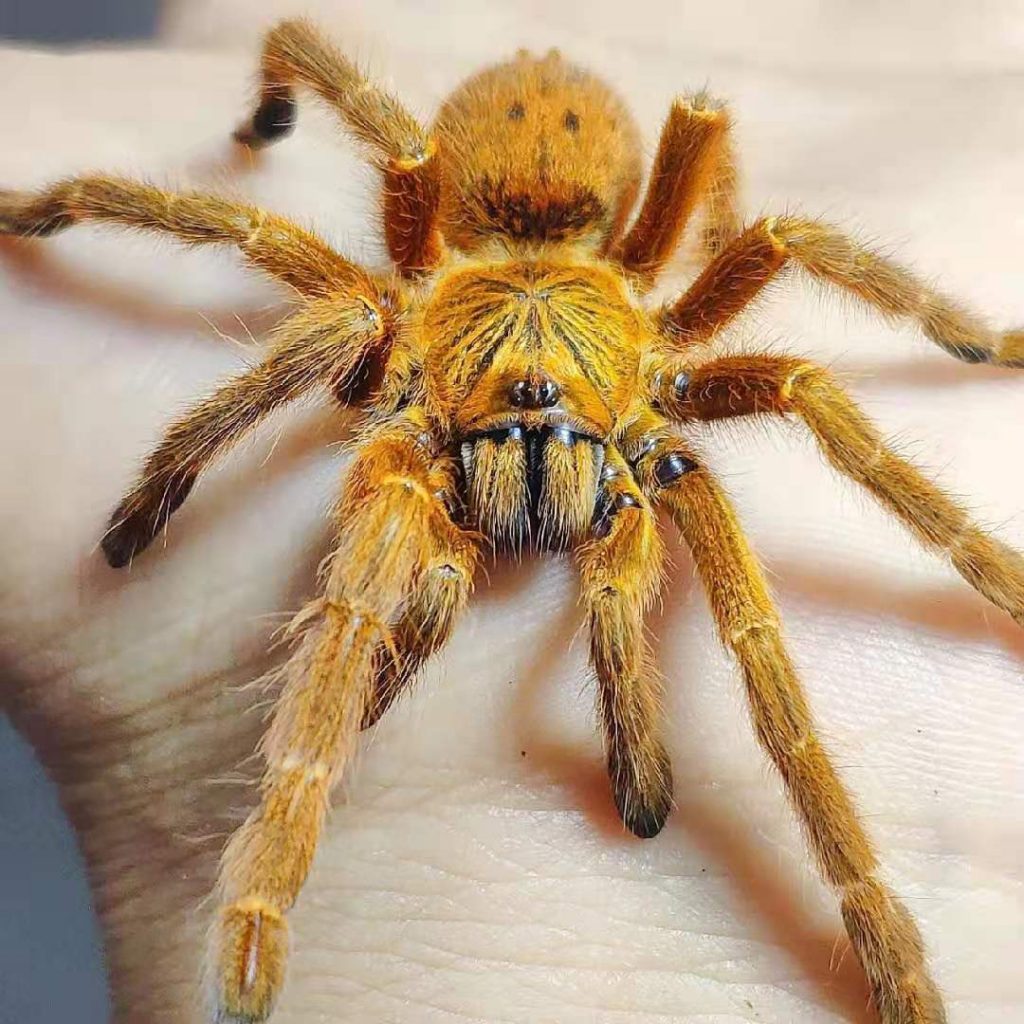
Orange Baboon Tarantula (Pterinochilus murinus) Care — The Tarantula Collective
I prepared an Exoterra 30x30x30cm terrarium for an Orange Baboon Tarantula. I decorated the interior with live succulents plants to mimic the environment a P.

Orange Baboon Tarantula (Pterinochilus Murinus) Care Guide Niche Pets
Pterinochilus murinus or the orange baboon tarantula, is an old-world tarantula that was first described in 1897 by Reginald Innes Pocock. This species is found on the African continent, in Angola, as well as central, eastern, and southern Africa.. Female P. murinus can grow to 4-6 inches (10-15cm) in size (measured from the tip of the.

Pterinochilus murinus Usambara (1.5cm) OBT
Size: Females are 4 - 6 inches (10.16 - 15.24 cm) long and males are 3 - 4 inches (7.62 - 10.16 cm). Color: They have an orange body with bright rings on their legs. However, they come in five color variants based on the region they occur. Brown Color Form (BCF) - Tete and Mozambique. Red Color Form (RCF) - Usambara Mountain area.

Pterinochilus murinus (Orange Baboon Tarantula, OBT) Spider, Tarantula, Baboon
In this video we cover care, husbandry, and feeding Pterinochilus murinus, also known as the OBT, Orange Baboon Tarantula, Mombasa Golden Starburst or Orange Bitey Thing. This includes.

Amazing African Ornamental Baboon Tarantula, part 2 (P. murinus) [Inferion7] YouTube
Males of these tarantulas smaller in size, sexual dimorphism before maturity do not possessed. For the species P. murinus known a few cases of laying several (2-3) eggsacs after one mating within the time period of one month between the sac's. Spiderlings possess good appetite and grows qickly: males can reach sexual maturity within the year.

Pterinochilus murinus var. Red Color Form (Mygale babouin orange)
Pterinochilus murinus Read our Complete Guide to Classification of Animals. Orange Baboon Tarantula Conservation Status Not Listed Orange Baboon Tarantula Locations Africa Orange Baboon Tarantula Facts Prey insects, lizards, mice, birds, crickets, roaches Main Prey insects

Pterinochilus murinus DCF "Mikumi NP" Tarantula about 1/2" 3/4" Fear Not Tarantulas, Inc.
The Orange Baboon Tarantula also known as the "Orange Bitey Thing" is a species of tarantula from Eastern Africa. They can grow up to 6 inches in size. Males usually live to be around 6 to 8 years while females live easily between 8 to 12 years.. The p.murinus is a well known burrower and will burrow itself its own hide. In addition they.

P.murinus (TCF) MF Tarantula by Gottarantulas MorphMarket
The spiders involved were probably Sierra Leone mouse brown (Eumenophorus clementsi) or Sierra Leone greater mouse brown (E. murphyorum) tarantulas (Eumenophorinae). 11 A bite, said to be by 'Pterinochilus mammilatus' but more probably by the red/orange colour phase of P. murinus , has been reported but without clinical details. 12 A bite.

A guide to buying your first (Australian) tarantula Part One Do you need a permit
The pterinochilus murinus infographic includes that they are present in Angola, Eastern, Central, and Southern Africa, Kenya, Burundi, Zimbabwe, Zambia, and other African continents. They were first originated from Tanzania and Usambara. These larger tarantulas with a size of three to six inches dig their burrows themselves and use them for hiding.

P.murinus (Orange Baboon Tarantula) Moult by spidermattcouk on DeviantArt
The Orange Baboon Tarantula or the pterinochilus murinus is a handsome tarantula with a bright yellow-red-orange color that makes it more appealing. There are sunburn marks on its abdomen, and these unique patterns make it one of the most preferred tarantula. Table of Contents Scientific name Physical appearance of Orange Baboon Tarantula Size
Beautiful Usambara P. murinus Arachnoboards
Pterinochilus murinus is an old-world tarantula that was first described in 1897 by Reginald Innes Pocock. This species is found on the African continent, in Angola, as well as central, eastern, and southern Africa. It is a member of the subfamily Harpactirinae, baboon spiders. Specimen size: 2" Pterinochilus murinus DCF "Kigoma" $150.00

Pterinochilus murinus (Orange Baboon Tarantula, OBT) for sale HappyForestStore
Pterinochilus murinus or the orange baboon tarantula, [citation needed] is an old-world tarantula that was first described in 1897 by Reginald Innes Pocock. [1] This species is found on the African continent, in Angola, as well as central, eastern, and southern Africa. It is a member of the subfamily Harpactirinae, baboon spiders. [2]

Orange Baboon Tarantula (Pterinochilus murinus) Care — The Tarantula Collective
Pterinochilus murinus or the orange baboon tarantula, is an old-world tarantula that was first described in 1897 by Reginald Innes Pocock. [1] This species is found on the African continent, in Angola, as well as central, eastern, and southern Africa. It is a member of the subfamily Harpactirinae, baboon spiders. [2]
Pterinochilus murinus Usambara Arachnoboards
Pocock, 1897 Among those who keep tarantulas as pets Pterinochilus murinus is known as "OBT," which means "Orange Baboon Tarantula" or "Orange Bitey Thing," and also as the "Pterror," a pun on its Latin genus classification: Pterinochilus. These nicknames reference a particular orange color form that is prized in the hobby for its beauty and confrontational personality.

Orange Baboon Tarantula (Pterinochilus murinus) Care — The Tarantula Collective
Common name: Usambara Indigenous: Angola, Burundi, Tanzania, Dem. Rep. Congo (Zaire), Kenya, Mozambique, South Africa, Sambia and Simbabwe Habitat: Savannah/Desert Temp/humidity: 18°C (65°F) in the extreme south, while in the hot season most parts of the coast average 27° to 28°C (80° to 82°F).

Orange Baboon Tarantula Pterinochilus murinus (Orange Baboon Tarantula) Spider, Tarantula
The Orange Bitey Thing - Latin name Pterinochilus murinus - is one of the most widespread of African tarantulas. Originally described by Reginald Pocock in 1897, this species may be found in much of Central, Eastern and Southern Africa, including Zaire, Kenya, Mozambique, Zimbabwe and Tanzania.